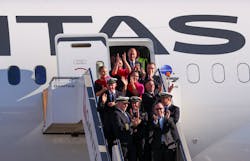I just took the world’s first 20-Hour flight. Here’s what it did to me
SYDNEY, Australia - I’ve just endured the world’s newest longest flight, a 16,200 kilometer (10,100 mile), nonstop ultra-marathon from New York to Sydney. It took about 19 and a half hours, and was almost as demanding as that sounds. The record-breaking Qantas Airways Ltd. flight touched down early Sunday morning in Australia. The Boeing Co. Dreamliner delivered its few dozen passengers — including yours truly — to their destination more or less intact, even if some of us were not quite sure what day it was, writes Angus Whitley for Bloomberg. Continue reading original article
The Intelligent Aerospace take:
October 21, 2019-Whitley's experience was indeed a novel one. The ultra-long haul flight was done as part of a research project Quantas undertook to explore ways to keep the human body and psyche from cracking under the pressure - or rather, lack of it - as well as tight spaces and jet lag. The Quantas flight flipped its normal service to specifically get its passengers on Sydney time as it took off from New York by keeping the lights on for the first six hours. In addition, experiments on pilots monitored brain waves, melatonin levels, and alertness. Passengers were also led through exercise classes.
“We know ultra long haul flights pose some extra challenges but that’s been true every time technology has allowed us to fly further. The research we’re doing should give us better strategies for improving comfort and wellbeing along the way," says Qantas Group CEO Alan Joyce. "“What’s already clear is how much time you can save. Our regular, one-stop New York to Sydney service (QF12) took off three hours before our direct flight but we arrived a few minutes ahead of it, meaning we saved a significant amount of total travel time by not having to stop."
Qantas Captain Sean Golding, who led the four pilots operating the service, said: “The flight went really smoothly. Headwinds picked up overnight, which slowed us down to start with, but that was part of our scenario planning. Given how long we were airborne, we were able to keep optimizing the flight path to make the best of the conditions. We had a lot of interest from air traffic controllers as we crossed through different airspace because of the uniqueness of this flight. We also had a special sign off and welcome home from the control towers in New York and Sydney, which you don’t get every day. Overall, we’re really happy with how the flight went and it’s great have some of the data we need to help assess turning this into a regular service.”
Related: Airbus makes a splash on the first day of Paris Air Show 2019 by announcing the A321XLR
Jamie Whitney, Associate Editor
Intelligent Aerospace
